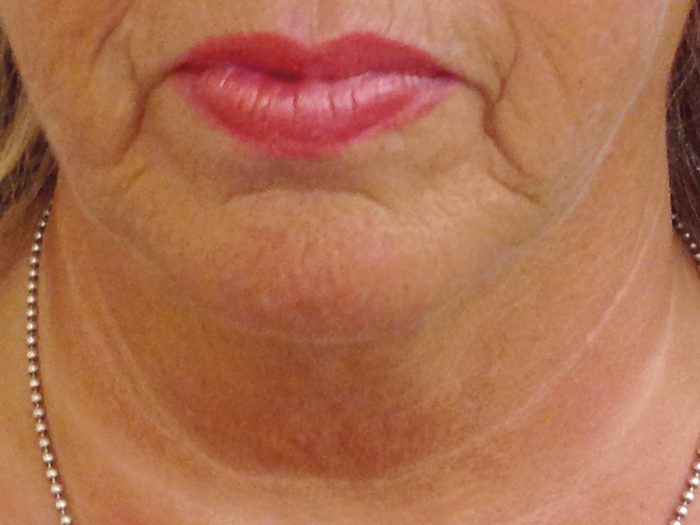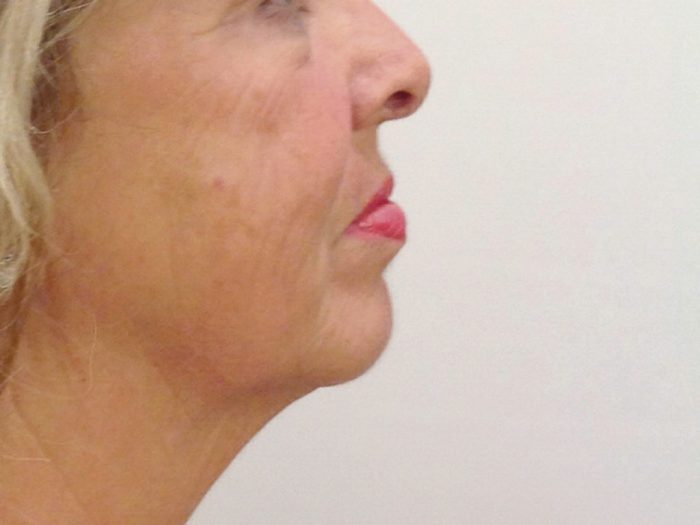Forma case study
The second part of this facial aesthetics case study looks at an eight-week course of treatments
During the natural ageing process, the production of our own collagen is reduced and the elasticity of our skin degrades. There is an increasing popularity within our population today of people seeking non-invasive alternatives to skin tightening procedures to help combat the first signs of aging.
As mentioned in our previous article (SDM Nov/Dec 2016), Forma (InMode Inc, Richmond Hill, ON, Canada, North America) is a FDA-approved bipolar, non-invasive radio frequency (RF) device that generates controlled dermal heating.
Forma is based on ACE (Acquired Control Extend) technology which is comprised of the following steps:
At the end of the treatment process, our patient was extremely happy with the results she achieved. There were no adverse reactions experienced throughout this course of treatment
- Acquire – Forma has a temperature sensor built into the handpiece which reads skin surface temperature 1,000 times per second, allowing clinicians to acquire skin temperature in real time.
- Control – Software algorithm allows unprecedented safety of RF delivery. The ‘cut off temperature’ feature reduces RF energy automatically when the handpiece senses that the required skin temperature has been reached.
- Extend – Clinical evidence suggests prolonged exposure to temperature above 40º C is advantageous for optimal clinical outcomes. Only InMode’s ACE technology allows you to utilise therapeutic temperatures safely and efficiently 1
Non-invasive skin tightening represents a rapidly emerging area in cosmetics, as patients increasingly seek to avoid facelifts and other invasive procedures. Non-ablative heating of the dermis and subcutaneous tissue offers the potential for skin tightening and rhytid reduction with minimal pain, downtime, and low risk of scars or other adverse events 2.
Forma is a non-invasive treatment that can be used to target fine lines, wrinkles and loose/lax skin. This treatment will stimulate new collagen formation within the skin which in turn will improve elasticity and give skin a firmer, rejuvenated appearance.
This RF device offers several advantages over currently available technologies, which likely explains this high level of clinical efficacy. The Forma device utilises real-time temperature-monitoring mechanisms, assessed by measuring tissue impedance, temperature, and epidermal contact throughout the treatment. This allows the device to continuously monitor the targeted tissue, and adjust the delivery of the RF energy to create a uniform heating exposure. The device is also able to maintain this constant uniform heating exposure for prolonged periods over relatively large treatment areas, such as an entire unilateral cheek. This uniform, long exposure is likely more effective at inducing collagen remodelling and neocollagenesis. Additionally, since the thermal exposure can be extended and prolonged, lower temperatures that do not induce any pain can be utilised 2.
The main goal for this case study is to provide further information on alternative non-invasive procedures and to demonstrate the results that can be achieved from ACE technology.
Case study
- Fig 1: first appointment
- Fig 2: first appointment
- Fig 3: first appointment
- Fig 4: final treatment
- Fig 5: final treatment
- Fig 6: Before and after comparison
- Fig 7: Before and after comparison
- Fig 8: Comparison photo
A 58-year-old female patient with skin type II, concerned about the appearance of her lower face (jowls and nasolabial folds) and neck area.
During the initial consultation the main areas of concern for the patient were established. Information was then given to the patient on the Forma treatment – how the treatment works, advised treatment schedule and the benefits. Throughout this discussion, the patient was able to ask any questions they had on the treatment.
Contraindications of the treatment were then discussed. Contraindications include – pacemaker or internal defibrillator, permanent implant in the treatment area, cosmetic fillers in the last six months, botox within the last week, a history of skin cancer or pregnancy/nursing mothers.
After all of the relevant information was given to patient and any questions answered, the patient was then able to make an informed decision as to whether she would like to proceed with the case study. Pre–treatment photos were then taken (Figs 1-3). It is essential to take pre-treatment photographs as this will provide you with a reference point throughout the entire treatment.
Treatment
The proposed treatment schedule for our patient to be able to obtain the optimum results was eight sessions of Forma at weekly intervals. Each session would last one hour and would involve treating both sides of the lower face and neck. Throughout the entire process, the patient’s face was divided into three treatment zones – right side of face, left side of face and neck. These three areas were then further divided into treatment areas which were roughly 10x10cm in size.
Each sub-divided treatment area was concentrated on individually for 10 minutes giving a total treatment time of 60 minutes. The patient’s tolerance to the treatment was very good, so the working parameters were set to the maximum recommendations from the machine’s manufacturer:
- RF = 62 for lower face (jowls and around mouth)
Temp = 43 - RF = 50 for neck, Temp = 43.
The radio frequency was reduced when treating the neck area as the skin in this area tends to be thinner and patients tend to find this area more sensitive to treat. Once the set working temperature was achieved, each area was then treated for 10 minutes. The length of time it takes to achieve the required working temperature varies depending on various external factors such as temperature of room, surface temperature of patient’s skin, etc.
After every treatment, the machine was appropriately cleaned down using 70 per cent alcohol as recommended by the manufacturer. It is essential that the appropriate safety checks are always carried out by the operator prior to use.
Feedback was obtained from our patient throughout the treatment process. She reported that she found the treatment very relaxing and could feel and see the difference in her skin after the first few treatments.
At the end of the treatment process – post-treatment photos were taken (Figs 4 and 5) and compared to original photos taken at the initial consultation (Figs 6, 7 and 8).
My experience working with the InMode Machine
As a fully qualified dental nurse, providing treatments that offer a non-invasive alternative to skin tightening is a relatively new field for me. I am aware of the increasing popularity within our population today of people seeking a wide range of facial aesthetic procedures. The InMode machine is an excellent piece of equipment to work with; it offers the clinician operating it a great deal of reassurance and confidence when providing a treatment due to all the built in safety mechanisms.
For example – monitoring the skin’s surface temperature 1,000 times per second throughout the Forma procedure. The machine is very well ergonomically designed which allows the operator to provide treatments with ease. The only minor difficulty I have occasionally experienced when providing a Forma facial is the position of the cable that attaches the handpiece to the machine. When treating a patient’s neck area, the cable can occasionally sit against their shoulder due to the working angle. However, if this is explained to the patient at the time they are always very understanding.
Results
There was a noticeable improvement in the appearance of fine lines with the skin looking rejuvenated from the treatment. The overall results from this course of treatment were excellent with the biggest change seen on the neck area – the loose/lax skin on the neck now appears much firmer than in the pre-treatment photos.
At the end of the treatment process, our patient was extremely happy with the results she achieved. After a discussion with the patient it was agreed that we had achieved a moderate result after the eight sessions of Forma. There were no adverse reactions experienced throughout this course of treatment.
The results achieved in this case were comparable to the results from a study carried out in America in 2015 3. This study was carried out treating fifteen patients with an average age of 62. They reported: “Results: All patients (14/14) were determined to have a clinical improvement, as the pre-treatment and post-treatment photographs were correctly identified by the evaluators. It was observed that 21 per cent (3/14) of patients had significant improvement, 50 per cent (7/14) had moderate improvement, and 29 per cent (4/14) had mild improvement. No pain, side-effects, or adverse events were observed.”
Feedback from all of our patients is vitally important to us. Throughout every stage of the Forma treatment and we regularly monitor how the patient is finding the treatment and if they have noticed a change in the appearance/texture of their skin. It is also important to find out how the patient is coping with the treatment, if there is anything we could do or change to improve their experience of the Forma facial.
It is also important to manage an individual’s expectations from the initial consultation throughout the treatment to the final appointment. Due to the fact Forma is a non-invasive and non-surgical procedure, it is impossible to achieve the dramatic changes you see with any invasive procedures. Patients and treatment providers will be able to see clinical improvements in their skin, however this is achieved gradually throughout the process, hence the importance of pre and post-treatment photographs.
Unrealistic expectations can leave patients feeling disappointed and disheartened with the treatment they had. If a patient is looking for a drastic change in areas of loose/lax skin and are not opposed to invasive procedures, it may be a better option for them to seek information for a suitably qualified professional on the other treatments available to them prior to proceeding with a course of Forma.
References
- inmodemd.com
- Nelson A, Beynet D and Lask GP. Non-invasive facial aesthetics. Scottish Dental magazine, Nov/Dec 2016: 52-54.
- Nelson A, Beynet D, Lask GP. A novel non-invasive radiofrequency dermal heating device for skin tightening of the face and neck. J Cosmet Laser Ther. Vol. 17, Iss. 6, 2015.
About the author
Megan Brown is a dental nurse/face and body cosmetic therapist at the Scottish Centre for Excellence in Dentistry in Glasgow.
Verifiable CPD Questions
AIMS and objectives:
- To give the reader a basic understanding of a non-invasive alternative to skin tightening available today.
- To provide additional information on radio frequency treatments that are becoming increasingly popular to target the initial signs of aging.
- To introduce a basic understanding of how Forma is used and what the procedure involves.
Learning outcomes:
- To understand how Forma treatment works and what results can be achieved.
- To be able to offer advice to patients should they request information on any non-invasive alternatives to skin tightening.
- To understand the advantages of Forma over other technologies that are currently available.








Comments are closed here.